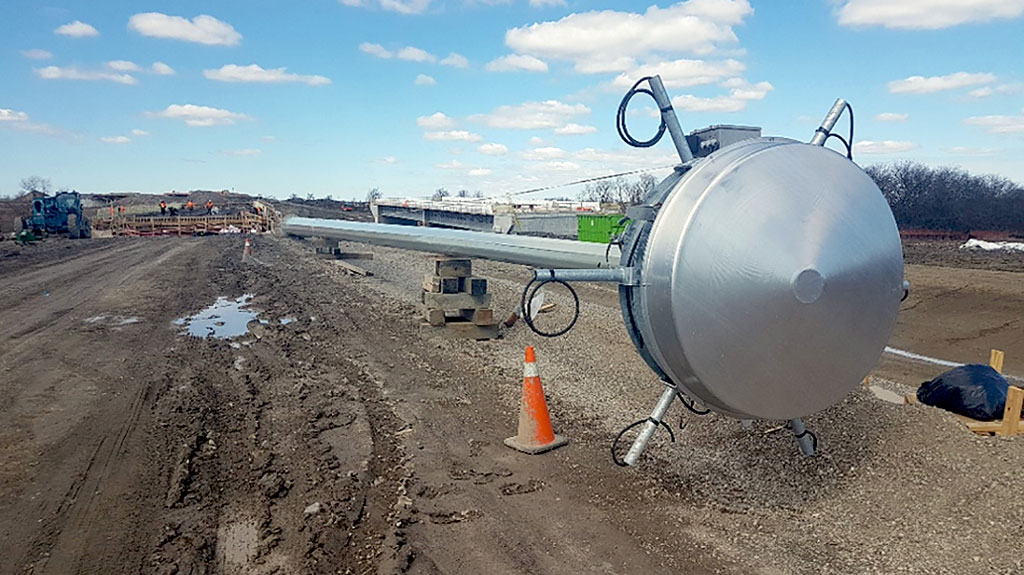Two large trucks, one loaded with rock and debris, the other with building materials, pass each other along the Highway 427 construction site at Langstaff Road in Vaughan, Ont., their tires kicking up plumes of dust.
Nearby, a roller is smoothing a ribbon of asphalt. High-mast light poles are strewn along the sides of the road, ready to be erected. There are piles of dirt everywhere, along with dozers, excavators and bobcats.
The project is a $616-million road widening and expansion of the highway from Toronto into Vaughan. Four kilometres of the existing highway from Finch Avenue and Highway 7 is being widened and the roadway is also being extended 6.6 kilometres from Highway 7 to Major Mackenzie Drive.
The stretch goes on as far as the eye can see. In this instance, it was drone footage of the project courtesy of LINK427, the consortium doing the work. The group includes ACS Infrastructure Canada Inc., Brennan Infrastructures Inc. and Dragados Canada Inc. Design is by MMM Group Ltd. and Thurber Engineering.
The project, which started in spring 2017, is now entering the final year of construction and completion is expected in 2021.
“High-mast light poles and footings for overhead signage are currently being installed along the expanse of the project along with bridge construction, grading and asphalt paving,” explains Jim Faught, spokesman for LINK427.
When complete, the expansion will feature three new interchanges at Langstaff Road, Rutherford Road, and Major Mackenzie. New overhead signs will also be installed.
On any given weekday, there are approximately 250 to 300 trades working on the project, most from the Greater Toronto Area.

Work has been able to proceed despite COVID-19 and the contractors and workers have followed a document circulated by Ontario’s chief prevention officer that provides guidance to help employers understand their responsibilities and what’s needed to prevent the spread of the virus on jobsites.
“Construction is proceeding as planned along with the various challenges provided while working within the measures from the COVID-19 pandemic,” says Faught.
The consortium knows how important infrastructure is to people and the economy, he says, but nothing is more important than protecting the health and wellbeing of Ontarians.
“While our government declared critical infrastructure projects as essential work that needed to continue, this was done in a way that ensured employers were fully aware of their obligations to keep their work sites and employees safe,” he adds.
Work has been taking place concurrently at separate locations along the route between Finch Avenue and Highway 7. A more linear approach to the build is being taken on the expansion section of the highway.
Girder installation on many of the bridges on the route began in 2019 and will be completed by the end of this year. The bridgework is complex. First piles and footings are installed, followed by construction of abutments and piers and then the installation of the concrete deck and asphalt layer on top.
The type of bridges most commonly used on the expansion are integral bridges. This means the deck of the bridge is contiguous with the approach slab. This is better for long-term maintenance of the bridge, especially during winter. The approach slab provides a transition between the road and bridge abutment.
Last year, the consortium took the unusual step of moving an existing Highway 427 bridge at Albion Road six metres to the west using a Self-Propelled Modular Transporter (SPMT) machine. The original plan was to demolish part of the bridge and build a new portion on the other side, as the location conflicted with the overall Highway 427 widening work. However, the consortium took a different approach.
“Moving the bridge was necessary so that the new eight-lane highway could be built,” says Faught. “LINK427 decided to use a value-engineering approach instead. Since the existing bridge was in good condition, LINK427 determined this approach would be the most effective method to move the structure.”
The novel approach also minimized the duration of the impact to users of the roadway, promoted the reuse of infrastructure and reduced waste.
Between a Friday and Sunday night, the top of the bridge was disconnected from the walls and footings. The structure was then moved using the SPMT, set down in its final position and reconnected.
Doing the work over a weekend closure provided the most socio-economic value for users, as it minimized overall construction impacts in the area, says Faught.
Paving on the 427 extension began last summer and has continued as work has progressed along the thoroughfare. Crews began laying asphalt just north of Zenway Boulevard and are continuing northward from Highway 7 to Major Mackenzie Drive as construction proceeds throughout the rest of the year.











Recent Comments